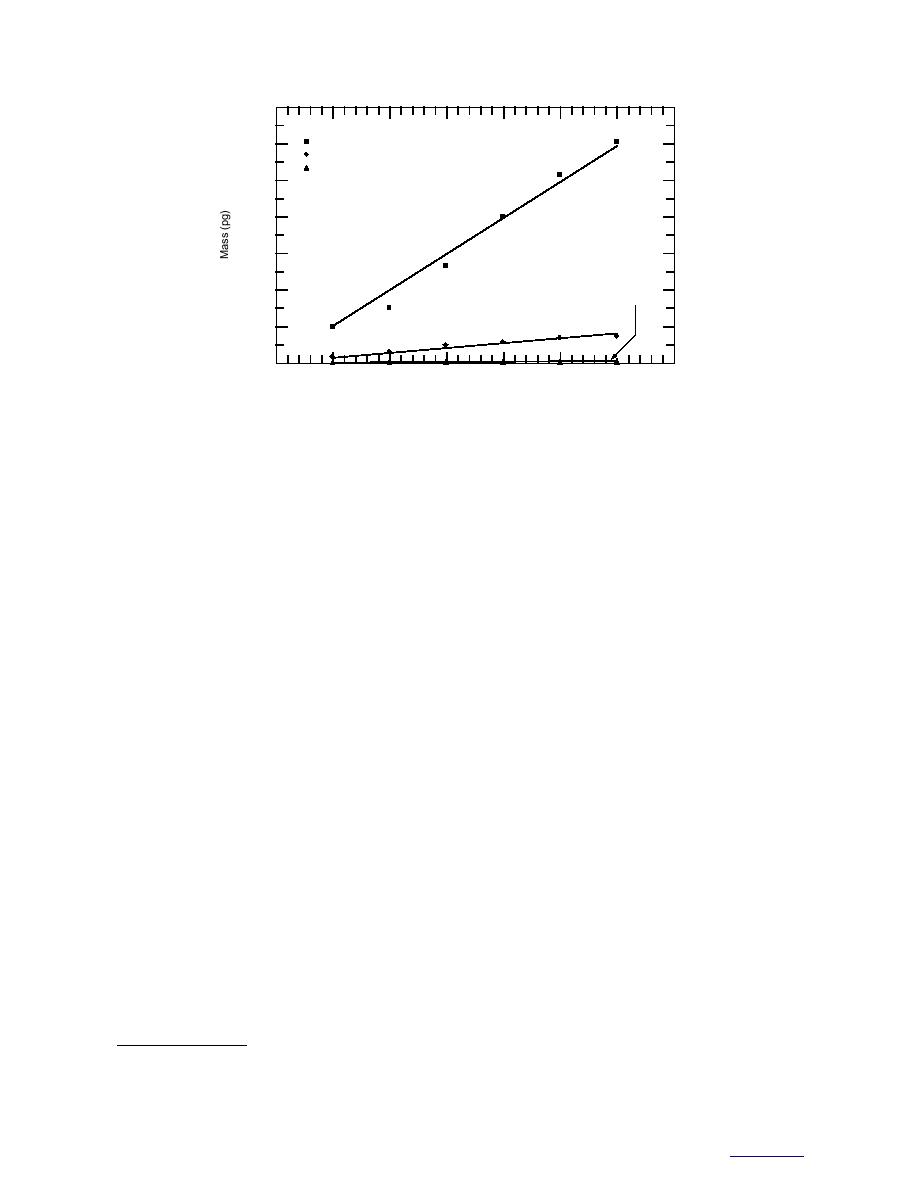
7,000
^
23C
y = 197x
6,000
4C
2
r = 0.980
12C
5,000
4,000
3,000
^
y = 1.30x
2,000
2
r = 0.706
^
y = 26.4x
2
r = 0.947
1,000
0
5
10
15
20
25
30
0
35
Time (min)
Figure 6. Mass of TNT vapor collected on polyacrylate SPME fiber at differ-
ent temperatures.
In an early experiment, we examined the rela-
1012 g of TNT, it would require air sample vol-
tionship between mass of TNT collected and the
umes of 10 mL or so to deliver a detectable mass of
length of time the fiber was exposed to the equilib-
TNT to the GC if the vapor concentration was 1013
rium vapor above military-grade TNT. This was
g/mL; direct injection of that volume of air con-
done by placing 28 mg of U.S. military-grade TNT
taining semi-volatile organics with very low vapor
in a 40-mL amber vial and allowing it to equili-
pressures is difficult to achieve without losses.
brate for 3 days at room temperature. A polyacry-
The major difficulty with the use of the SPME
late SPME fiber (85 m) was inserted into the vial
fibers for this application is the difficulty of pro-
and was exposed to the vapor for periods ranging
viding quantitative calibration. Instrument
from 5 to 30 minutes. This was done at all three
responses for explosives vapors obtained by
temperatures used in the soil study: 23, 4, and
SPME can easily be calibrated with respect to
-12C. A plot of the mass of TNT collected as a
mass. Using liquid standards to obtain response
function of exposure time for each temperature is
factors, we can convert to mass of TNT a peak
height (or peak area) for TNT in the GC-ECD
shown in Figure 6. The results indicate that the
mass of TNT collected is linearly related to expo-
chromatogram from a sample preconcentrated on
sure time through 30 minutes for all three temper-
a SPME fiber. However, to convert this mass to a
atures. In this experiment, there was a 20-minute
vapor concentration in the headspace, the volume
recovery period between exposure periods, and in
sampled by the fiber needs to be known.
order for linearity to be maintained over the entire
Previous approaches to calibration for SPME
experiment, this recovery period must have been
assume that equilibrium is reached between the
adequate to reestablish equilibrium between the
fiber and the vapor (Zhang and Pawliszyn 1993,
TNT in the vapor and the solid.
Martos and Pawliszyn 1998). Experiments at San-
Because the mass of TNT collected by the fiber is
dia National Laboratory* and here at CRREL indi-
linearly related to exposure time, the TNT in the
cate that equilibrium for TNT is not reached even
vapor cannot be depleted substantially in the va-
when the headspace is exposed to the fiber for sev-
por during sampling. To directly assess the rate at
eral days. One exception is the dimethysiloxane
SPME fiber with only a 7-m coating. In that case,
which TNT in the vapor could be depleted using
the SPME fibers, the following experiment was
equilibrium appears to be reached more quickly
conducted. An 80-mg portion of U.S. military-
(order of minutes to hours), but little preconcen-
grade TNT was placed in a 40-mL amber vial and
tration is achieved. This has been verified at both
the headspace was allowed to equilibrate for 7
CRREL and Sandia.
days at 23C. The headspace in the vial was then
sampled using polyacrylate SPME fibers continu-
* Personal communication with William Chambers, Sandia National
ously for 200 minutes in 20-minute increments.
Laboratory, 1998.
8
To Contents



 Previous Page
Previous Page
